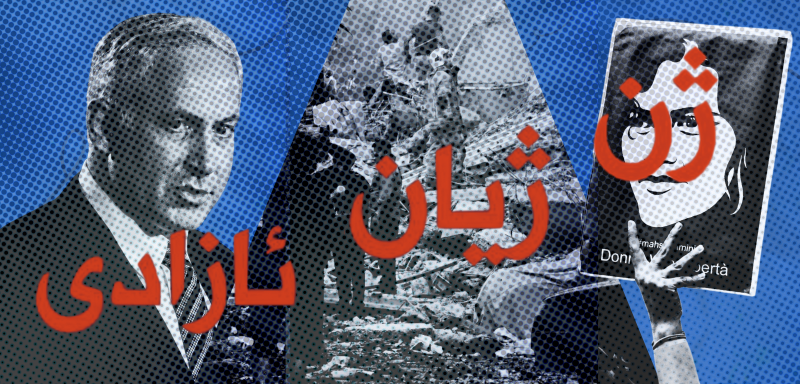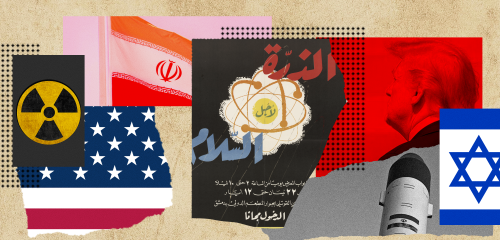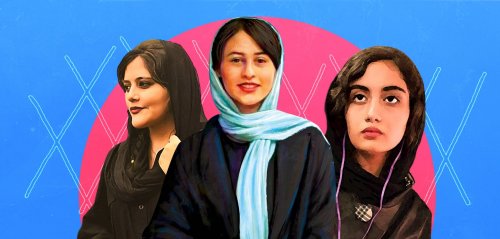A year into Israel’s genocide in Gaza, Babak Esghandi was wrapping up on reporting work in the territory. While international journalists had generally not been permitted entry into Gaza, Esghandi, the Israel correspondent from an Iranian opposition outlet, was a rare exception. Standing in a bombed-out building, he scrawled, in green marker, the Farsi words for ‘Woman, Life, Freedom’ onto its concrete skeleton. A “memento” from the Iranian people, he said.
The vandalism of a destroyed Palestinian home, done with the casual air of a tourist signing a guestbook, and the appropriation of a slogan insisting on life in the face of state brutality, was particularly blood-boiling to many Kurds and Iranians.
Where Hamas is the Iranian state-backed, Islamist enemy of feminism, Israel, its bombardment, and the ‘Woman, Life, Freedom’ slogan, are presented as the antidote. Esghandi was the antidote’s vector, a syringe into the arm of the afflicted.
Where Hamas is the Iranian state-backed, Islamist enemy of feminism, Israel, its bombardment, and the ‘Woman, Life, Freedom’ slogan, are presented as the antidote.
On June 13, eight months after Esghandi posted the video, Israel—its bloodlust still unsatiated—launched a bombing campaign on Iran. In a fortnight, hundreds of Iranian civilians were killed, over 100 women among them.
From the start of the bombardment, Israeli Prime Minister Benjamin Netanyahu used the ‘Woman, Life, Freedom’ slogan as a rallying call for Iranians at home and in the diaspora. Conveyed in both English and Farsi, he disguised his bombing campaign as a catalyst through which to overthrow the regime.
“I know your great slogan, Zan, Zandegi, Azadi… it’s Woman, Life, Freedom,” the Prime Minister said in an interview with Iran International. While Netanyahu boasted of female Israeli fighter pilots over the skies of Iran, his government killed Iranian women like Parnia Abbasi, who looked up at the same skies for poetic inspiration.
The shadow of war provides generous cover and fresh pretext for the rewriting of history, the co-optation of slogans, and the warping of language. The more Zionists co-opt ‘Woman, Life, Freedom’ to justify death and destruction in Palestine and in Iran, the further it is torn from its life-affirming origins in resistance and the movement that had fostered solidarity between Kurdish, Iranian, Palestinian women.
Born at a funeral
In September 2022, Jina Mahsa Amini — Jina her Kurdish name, Mahsa her government-approved Farsi name — was fatally beaten while she was held in state custody. The 22-year-old had been arrested in Tehran by morality police, supposedly for violating the state’s strict dress code for Iranian women.
The state-sanctioned murder of Jina — whose name derives from the Kurdish word for life — launched an uprising of unprecedented scale. From her funeral in Saqqez, Iranian Kurdistan, mourners chanted in Kurdish, ‘Jin, Jiyan, Azadi.’
Her death ignited existing national anger not only against violent enforcement of mandatory hijab on an unprecedented scale, but gender-based oppression and the country’s repressive regime. This anger was succinctly captured by the ‘Woman, Life, Freedom’ chant heard across Iran.
Despite the new unities, marginalization of ethnic minorities persisted in how the movement was narrated: in their reporting of the Jina Uprising, international media, publishers, and academics often only translated the ‘Woman, Life, Freedom’ slogan into Farsi and erased it of its Kurdish history.
In response, Kurdish, Iranian, and other academics moved to recontextualize the slogan, and emphasize its Kurdish and transnational origins. Academic Somayeh Rostampour has traced the existence and use of the slogan from Turkish Kurdistan in the early 2000s as a challenge to the patriarchy of Kurdish politics and movements, to the Rojava revolution and prisons in Iran in the 2010s, then to the Jina Uprising in Iran. Throughout, the slogan has been used in women-led spaces for the contemporaneous commemoration of the dead and celebration of life at burials, funerals, and vigils.
One of the earliest appearances of the ‘Woman, Life, Freedom’ slogan was reported from Evin prison. The slogan was written on the cell wall of Shirin Alamholi, a prisoner executed by the Iranian regime in 2010 on allegations of belonging to a Kurdish armed group—long before the phrase gained international recognition with the Jina Uprising.
In a letter from Evin last year, activist Sepideh Qolian wrote of the Woman, Life, Freedom movement as resistance to state necropower: “‘Jin, Jiyan, Azadi’ is not merely a slogan — it is an open wound, a scar etched into this land that, despite its pain, continuously gives birth to life… This slogan represents a roadmap for survival in a land where death has been institutionalized.”
Woman, Life, Freedom’s Kurdish origins cannot be understated, because Kurds are, or have been, a vilified “other” in all of the countries that Kurdistan straddles. Where they have been branded a threat to national identities, the necropolitics of sovereign states like Iran have sought to erase the Kurdish “other” through linguicide, religious suppression, environmental destruction, and systematic de-development of Kurdish-majority areas. Failure to bend to a life of severe restriction and sterilized cultural and identity expression makes these populations subject to arbitrary arrests, imprisonment, capital punishment, and extrajudicial killings.
Sovereign states like Iran have sought to erase the Kurdish “other” through linguicide, religious suppression, environmental destruction, and systematic de-development of Kurdish-majority areas. Failure to bend to a life of severe restriction and sterilized cultural and identity expression makes these populations subject to arbitrary arrests, imprisonment, capital punishment, and extrajudicial killings.
In a stark demonstration of the inequities in Iran, Kurds, who account for only about ten percent of the population, made up more than three-quarters of executions carried out in Iran in 2024 for political and religious charges, including espionage for Israel and involvement in the Jina Uprising. The confessions for these crimes are often extracted under duress, and all of the accused Kurdish groups deny ties to Israel or the United States; dually, neither the United States nor Israel have publicly claimed to support specific Kurdish separatist groups in Iran.
Iran accuses the US and Israel of using Iranian Kurdish opposition and separatist groups to force regime change, so when there is military escalation between Iran and Israel or the US, Kurds are often Tehran’s first and primary target.
Killed by whose hands
In the days and weeks since June 13th, Iran has been using the war to intensify repression, on the pretext of shutting down foreign threats. Women — Kurdish women in particular — are far from exempt.
Last week, Iranian state media said that its security forces had arrested some 700 “Israeli spies” since Israel bombed Iran. Kurds, consistently among Tehran’s most likely suspects, made up a disproportionately high number of the arrests. An estimated 300 Kurds had been arrested during that time period, mostly on allegations of espionage for Israel or for trying to bring down the state, according to Kurdish rights organization Hengaw. Among those arrested were 26 Kurdish women of a total of 40 across Iran.
Evin prison, which holds thousands of Iranians, including those who participated in the Women, Life, Freedom movement, was bombed by Israel on June 23, killing more than 70 people, including at least two inmates. The death toll could be far higher, with some 100 transgender prisoners who had been held at Evin missing and presumed dead, a human rights lawyer in Iran has said.
Israel claimed that bombing Iran was a catalyst for liberation, a crutch on which an uprising against the regime could raise itself. Instead, it endangered the lives of prisoners, including those who had fought for freedom.
Israel claimed that bombing Iran was a catalyst for liberation, a crutch on which an uprising against the regime could raise itself. Instead, it endangered the lives of prisoners, including those who had fought for freedom.
Setting greedy sights further across the Middle East while committing genocide in Palestine, Netanyahu has used the Woman, Life, Freedom slogan before. After the Tehran-allied Syrian regime fell in December 2024 — which he claimed was “a direct result of the blows we have inflicted on Iran and Hezbollah” — he said: “Woman, Life, Freedom is the future of Iran.”
Israel may position itself as Iran’s ideological polar opposite, but Israeli brutality has conspired to raise fear and likelihood of death for the Iranian women Netanyahu claims to side with.
Netanyahu and other Israeli officials continue to claim that they are freeing Palestinian women in Gaza from dehumanization and sexual violence by Hamas and its fighters. “Help us get rid of Hamas,” Netanyahu said in a podcast interview last month, seemingly addressing Palestinians. “They torment you. They oppress you. And if you are a woman, you are chattel. You are nothing. You are property. That's the opposite of everything we believe.”
While claiming to help Palestinians in Gaza free themselves from Hamas, Israel has killed tens of thousands of women and girls in its genocide, and has now extended its violence to women in Iran.
More than 15 years of Israeli siege and occupation were already inflicting slow death on Palestinians in Gaza. Israel is now suffocating life there with ever-tightening grip, its killing of penned-in Palestinians sped up by near-constant bombing and intensification of engineered famine.
Palestinian women are not collateral damage of war, but deliberate targets of Israel’s death machine. Palestinian women and girls account for 57 percent of all confirmed deaths in Gaza since October 2023, according to the UN’s Human Rights Office of the High Commissioner (OHCHR). Palestinian women are forced to give birth in life-threatening conditions, hospitals and their reproductive care units obliterated by bombing; Israeli soldiers subject Palestinian women and girls to rape and other forms of sexual violence.
Earlier this month, UN Special Rapporteur Reem Alsalem said Israel was committing a “femi-genocide” in Gaza, with Israel “deliberately killing Palestinian women and girls with the intent to destroy them and the continuity of the Palestinian people.”
While committing this “femi-genocide” in Gaza, Israel bombed Iran in feigned support of the liberation of Iranian women. No Iranian or Palestinian woman was freed in this infliction of Israeli brutality packaged as salvation. Israel is currently killing a woman every hour in Gaza. And yet, Netanyahu, guardsman of a death-world, and his supporters still leech off ‘Woman, Life, Freedom.’
Israel is currently killing a woman every hour in Gaza. And yet, Netanyahu, guardsman of a death-world, and his supporters still leech off ‘Woman, Life, Freedom.’
Insistence on (popular) resistance
As Iran doubles down on its repression, and the threat of future Israeli bombing lingers, the Jina uprising persists almost three years since its start.
Netanyahu called on Iranians to rise up as if they had been dormant before June 13th, but Iranians of all stripes have been insisting on life and liberty, for women and for all, fully aware of the potential consequences. They did not plead for external military intervention, nor did they welcome intervention when it came; instead, they condemned it, and urged for its end.
In a letter released days before Israel bombed Evin, Kurdish and Iranian women political prisoners held at the prison — among them Warisha Moradi — wrote:
“The attack on Iran, the killing of civilians, and the destruction of the country's infrastructure by the 'Zionist regime' and their American supporters are all condemned… support for Israel and reliance on its destructive power—by any individual, group or political movement, regardless of their dreams or ideals—is condemned, as it reveals only the depravity and disgrace of its backers.
“Our liberation, the liberation of the people of Iran from the ruling dictatorship, is only possible through mass struggle and by relying on social forces—not by placing our hopes in foreign powers.”
As feminist activist and researcher Aram writes in an essay powerfully titled ‘Jina, the Moment of No Return,’ where Iranian state repression and control have smothered the space for “oppositional political organizing,” a different kind of solidarity, one between different workers, students, and others has grown. Iranian women prisoners speak in solidarity with striking truck drivers; shopkeepers shutter their storefronts to protest death sentences for women prisoners.
“A new generation has overcome the dominant depoliticized discourse and has politicized urban space and everyday life—a generation of political subjects who do not accept top-down leadership and who conceive of themselves as agents of change,” writes Aram.
In Iran’s new climate of resistance, the ousting of enemy rulers by a power like Israel so hellbent on death and destruction is not only incompatible, but antithetical to the origins and ideals of the Jina Uprising, and to the defense of Woman, Life, or Freedom.
Raseef22 is a not for profit entity. Our focus is on quality journalism. Every contribution to the NasRaseef membership goes directly towards journalism production. We stand independent, not accepting corporate sponsorships, sponsored content or political funding.
Support our mission to keep Raseef22 available to all readers by clicking here!
Interested in writing with us? Check our pitch process here!








